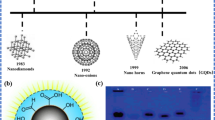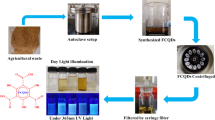Abstract
A novel enzyme-free hydrogen peroxide sensor composed of carbon dots (CDs) and multi-walled carbon nanotubes (MWCNTs) was prepared. It was found that the carbon dots-decorated multi-walled carbon nanotubes nanocomposites (CDs/MWCNTs) modified glassy carbon (GC) electrode (CDs/MWCNTs/GCE) exhibited a significant synergistic electrocatalytic activity towards hydrogen peroxide reduction as compared to carbon dots or multi-walled carbon nanotubes alone, and the CDs/MWCNTs/GCE has shown a low detection limit as well as excellent stability, selectivity, and reproducibility. These remarkable analytical advantages enable the practical application of CDs/MWCNTs/GCE for the real-time tracking of hydrogen peroxide (H2O2) released from human cervical cancer cells with satisfactory results. The enhanced electrochemical activity can be assigned to the edge plane-like defective sites and lattice oxygen in the CDs/MWCNTs nanocomposites due to the small amount of decoration of carbon dots on the multi-walled carbon nanotubes. Based on a facile preparation method and with good electrochemical properties, the CDs/MWCNTs nanocomposites represent a new class of carbon electrode for electrochemical sensor applications.

CDs/MWCNTs exhibited good electrocatalytic activity and stability to H2O2 reduction and can be used for real-time detection of H2O2 released from living cells.







Similar content being viewed by others
References
Ping J, Wu J, Fan K, Ying Y. An amperometric sensor based on prussian blue and poly(O-Phenylenediamine) modified glassy carbon electrode for the determination of hydrogen peroxide in beverages. Food Chem. 2011;126:2005–9.
Woo Y-A, Lim H-R, Kim H-J, Chung H. Determination of hydrogen peroxide concentration in antiseptic solutions using portable near-infrared system. J Pharm Biomed Anal. 2003;33:1049–57.
Lu X, Zhou J, Lu W, Liu Q, Li J. Carbon nanofiber-based composites for the construction of mediator-free biosensors. Biosens Bioelectron. 2008;23:1236–43.
Shu X, Chen Y, Yuan H, Gao S, Xiao D. H2O2 sensor based on the room-temperature phosphorescence of nano TiO2/SiO2 composite. Anal Chem. 2007;79:3695–702.
Baker SN, Baker GA. Luminescent carbon nanodots: emergent nanolights. Angew Chem Int Ed. 2010;49:6726–44.
Sies H. Biochemistry of oxidative stress. Angew Chem Int Ed Engl. 1986;25:1058–71.
Klassen NV, Marchington D, McGowan HCE. H2O2 determination by the I3- method and by KMnO4 titration. Anal Chem. 1994;66:2921–5.
Steinberg S. High-performance liquid chromatography method for determination of hydrogen peroxide in aqueous solution and application to simulated Martian soil and related materials. Environ Monit Assess. 2013;185:3749–57.
Matos RC, Coelho EO, Souza CF, Guedes FA, Matos MAC. Peroxidase immobilized on amberlite IRA-743 Resin for on-Line spectrophotometric detection of hydrogen peroxide in rainwater. Talanta. 2006;69:1208–14.
Wang T, Zhu H, Zhuo J, Zhu Z, Papakonstantinou P, Lubarsky G, et al. Biosensor based on ultrasmall MoS2 nanoparticles for electrochemical detection of H2O2 released by cells at the nanomolar level. Anal Chem. 2013;85:10289–95.
Wang L, Zhu H, Song Y, Liu L, He Z, Wan L, et al. Architecture of poly(O-Phenylenediamine)–Ag nanoparticle composites for a hydrogen peroxide sensor. Electrochim Acta. 2012;60:314–20.
Bui M-PN, Pham X-H, Han KN, Li CA, Kim YS, Seong GH. Electrocatalytic reduction of hydrogen peroxide by silver particles patterned on single-walled carbon nanotubes. Sensors and Actuators B. 2010;150:436–41.
Wang L, Wang E. A novel hydrogen peroxide sensor based on horseradish peroxidase immobilized on colloidal Au modified ITO electrode. Electrochem Commun. 2004;6:225–9.
Prakash P, Agarwal R, Singh N, Chauhan RP, Agrawal VV, Biradar AM. Fabrication of enzyme based electrochemical H2O2 biosensor using TiO2 as a matrix. Sens Lett. 2015;13:219–22.
Ernst A, Makowski O, Kowalewska B, Miecznikowski K, Kulesza PJ. Hybrid bioelectrocatalyst for hydrogen peroxide reduction: immobilization of enzyme within organic–inorganic film of structured prussian blue and PEDOT. Bioelectrochemistry. 2007;71:23–8.
Shoji E, Freund MS. Potentiometric sensors based on the inductive effect on the pka of poly(aniline): a nonenzymatic glucose sensor. J Am Chem Soc. 2001;123:3383–4.
Li X, Zhu Q, Tong S, Wang W, Song W. Self-assembled microstructure of carbon nanotubes for enzymeless glucose sensor. Sensors and Actuators B. 2009;136:444–50.
Xiao Y, Patolsky F, Katz E, Hainfeld JF, Willner I. “Plugging into enzymes”: nanowiring of redox enzymes by a gold nanoparticle. Science. 2003;299:1877–81.
Zhang Y, Sun Y, Liu Z, Xu F, Cui K, Shi Y, et al. Au nanocages for highly sensitive and selective detection of H2O2. J Electroanal Chem. 2011;656:23–8.
Chen H, Zhang Z, Cai D, Zhang S, Zhang B, Tang J, et al. A hydrogen peroxide sensor based on Ag nanoparticles electrodeposited on natural nano-structure attapulgite modified glassy carbon electrode. Talanta. 2011;86:266–70.
Zhang L, Li H, Ni Y, Li J, Liao K, Zhao G. Porous cuprous oxide microcubes for non-enzymatic amperometric hydrogen peroxide and glucose sensing. Electrochem Commun. 2009;11:812–5.
Chang Q, Deng K, Zhu L, Jiang G, Yu C, Tang H. Determination of hydrogen peroxide with the aid of peroxidase-like Fe3O4 magnetic nanoparticles as the catalyst. Microchim Acta. 2009;165:299–305.
Zhang X, Liu D, Yu B, You T. A novel nonenzymatic hydrogen peroxide sensor based on electrospun nitrogen-doped carbon nanoparticles-embedded carbon nanofibers film. Sensors and Actuators B. 2016;224:103–9.
Lin W-J, Liao C-S, Jhang J-H, Tsai Y-C. Graphene modified basal and edge plane pyrolytic graphite electrodes for electrocatalytic oxidation of hydrogen peroxide and Β-nicotinamide adenine dinucleotide. Electrochem Commun. 2009;11:2153–6.
Yang J, Liu D-J, Kariuki NN, Chen LX. Aligned carbon nanotubes with built-in FeN4 active sites for electrocatalytic reduction of oxygen. Chem Commun. 2008; 329–31.
Zhou M, Guo J, Guo LP, Bai J. Electrochemical sensing platform based on the highly ordered mesoporous carbon-fullerene system. Anal Chem. 2008;80:4642–50.
Banks CE, Davies TJ, Wildgoose GG, Compton RG. Electrocatalysis at graphite and carbon nanotube modified electrodes: edge-plane sites and tube ends are the reactive sites. Chem Commun. 2005; 829–41.
Shao Y, Sui J, Yin G, Gao Y. Nitrogen-doped carbon nanostructures and their composites as catalytic materials for proton exchange membrane fuel cell. Appl Catal B. 2008;79:89–99.
Gong K, Du F, Xia Z, Durstock M, Dai L. Nitrogen-doped carbon nanotube arrays with high electrocatalytic activity for oxygen reduction. Science. 2009;323:760–4.
Shao Y, Zhang S, Engelhard MH, Li G, Shao G, Wang Y, et al. Nitrogen-doped graphene and its electrochemical applications. J Mater Chem. 2010;20:7491–6.
Shen J, Zhu Y, Yang X, Li C. Graphene quantum dots: emergent nanolights for bioimaging, sensors, catalysis and photovoltaic devices. Chem Commun. 2012;48:3686–99.
Li H, Kang Z, Liu Y, Lee S-T. Carbon nanodots: synthesis, properties and applications. J Mater Chem. 2012;22:24230–53.
Li Y, Zhao Y, Cheng H, Hu Y, Shi G, Dai L, et al. Nitrogen-doped graphene quantum dots with oxygen-rich functional groups. J Am Chem Soc. 2012;134:15–8.
Jahanbakhshi M, Habibi B. A novel and facile synthesis of carbon quantum dots via salep hydrothermal treatment as the silver nanoparticles support: application to electroanalytical determination of H2O2 in fetal bovine serum. Biosens Bioelectron. 2016;81:143–50.
Razmi H, Mohammad-Rezaei R. Graphene quantum dots as a new substrate for immobilization and direct electrochemistry of glucose oxidase: application to sensitive glucose determination. Biosens Bioelectron. 2013;41:498–504.
Kang SH, Choi SH, Kang MS, Kim JY, Kim HS, Hyeon T, et al. Nanorod-based dye-sensitized solar cells with improved charge collection efficiency. Adv Mater. 2008;20:54–8.
Teng X, Ma C, Ge C, Yan M, Yang J, Zhang Y, et al. Green synthesis of nitrogen-doped carbon dots from konjac flour with “Off-on” fluorescence by Fe3+ and L-lysine for bioimaging. J Mater Chem B. 2014;2:4631–9.
Jia N, Wang Z, Yang G, Shen H, Zhu L. Electrochemical properties of ordered mesoporous carbon and its electroanalytical application for selective determination of dopamine. Electrochem Commun. 2007;9:233–8.
Cañete-Rosales P, Ortega V, Álvarez-Lueje A, Bollo S, González M, Ansón A, et al. Influence of size and oxidative treatments of multi-walled carbon nanotubes on their electrocatalytic properties. Electrochim Acta. 2012;62:163–71.
Seo PW, Cho SP, Hong SH, Hong SC. The influence of lattice oxygen in titania on selective catalytic reduction in the low temperature region. Appl Catal A. 2010;380:21–7.
Zhou X, Tian Z, Li J, Ruan H, Ma Y, Yang Z, et al. Synergistically enhanced activity of graphene quantum dot/multi-walled carbon nanotube composites as metal-free catalysts for oxygen reduction reaction. Nanoscale. 2014;6:2603–7.
Sun H, Liu Z, Chen S, Quan X. The role of lattice oxygen on the activity and selectivity of the OMS-2 catalyst for the total oxidation of toluene. Chem Eng J. 2015;270:58–65.
Liu S-Q, Ju H-X. Renewable reagentless hydrogen peroxide sensor based on direct electron transfer of horseradish peroxidase immobilized on colloidal gold-modified electrode. Anal Biochem. 2002;307:110–6.
Zhang Y, Yuan R, Chai Y, Xiang Y, Hong C, Ran X. An amperometric hydrogen peroxide biosensor based on the immobilization of HRP on multi-walled carbon nanotubes/electro-copolymerized nano-Pt-poly(Neutral Red) composite membrane. Biochem Eng J. 2010;51:102–9.
Guo S, Wen D, Dong S, Wang E. Gold nanowire assembling architecture for H2O2 electrochemical sensor. Talanta. 2009;77:1510–7.
Liu M, Liu R, Chen W. Graphene wrapped Cu2O nanocubes: non-enzymatic electrochemical sensors for the detection of glucose and hydrogen peroxide with enhanced stability. Biosens Bioelectron. 2013;45:206–12.
Dong S, Xi J, Wu Y, Liu H, Fu C, Liu H, et al. High loading MnO2 nanowires on graphene paper: facile electrochemical synthesis and use as flexible electrode for tracking hydrogen peroxide secretion in live cells. Anal Chim Acta. 2015;853:200–6.
Tan SJ, Jana NR, Gao S, Patra PK, Ying JY. Surface-ligand-dependent cellular interaction, subcellular localization, and cytotoxicity of polymer-coated quantum dots. Chem Mater. 2010;22:2239–47.
Acknowledgments
This work was financially supported by the National Science Foundation for Excellent Young Scholar of China (21322510), Science and Technology Innovation Foundation of Jilin Province for Talents Cultivation (Grants 20150519014JH), National Science Foundation for Young Scholar of China (21505130), and Youth Foundation of Jilin Province (20140520082JH).
Author information
Authors and Affiliations
Corresponding author
Ethics declarations
Conflict of interest
The authors declare that they have no competing interests.
Human and animal rights and informed consent
Informed consent was obtained from all individual participants included in the study. All procedures performed in studies involving human participants were in accordance with the ethical standards of the institutional and/or national research committee and with the 1964 Helsinki declaration and its later amendments or comparable ethical standards.
Electronic supplementary material
Below is the link to the electronic supplementary material.
ESM 1
(PDF 582 kb)
Rights and permissions
About this article
Cite this article
Bai, J., Sun, C. & Jiang, X. Carbon dots-decorated multiwalled carbon nanotubes nanocomposites as a high-performance electrochemical sensor for detection of H2O2 in living cells. Anal Bioanal Chem 408, 4705–4714 (2016). https://doi.org/10.1007/s00216-016-9554-4
Received:
Revised:
Accepted:
Published:
Issue Date:
DOI: https://doi.org/10.1007/s00216-016-9554-4




